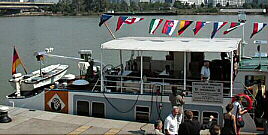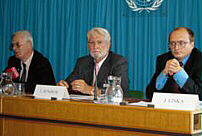 |
| The survey attracted a lot of public attention on its 2,581-km journey |
Over 140 different chemical determinands and biological parameters have been analysed and more than 40.000 laboratory results generated in the ICPDR survey that - for the first time - produced comparable data on biological parameters and chemical pollutants, aquatic flora and fauna and bacteriological indicators about the entire course of the river.
Towards a homogenous data set
The International Commission for the Protection of the Danube River (ICPDR)
initiated JDS to improve the validity and comparability of water quality
data received from its regular monitoring programme (Trans-National
Monitoring Network, TNMN). „The major goal of the survey was to produce
a homogenous data set of selected determinands for the whole Danube River
and to identify and confirm specific pollution sources“, explains ICPDR
Project Manager Igor Liska.
On August 14th, 2001, a team of ten scientists from Germany, Austria, Slovakia,
Hungary, Yugoslavia, Bulgaria and Romania boarded the German "Argus”
and the Hungarian "Széchényi” ships in Regensburg
and started their 2581-km, six-weeks' journey towards the Black Sea.
During its journey down the Danube, the survey attracted a lot of public
attention. It was followed by journal-ists and TV crews in all countries
and usually made it into the headlines of major national newspapers, radio
and TV news.
JDS was funded by Germany and Austria (Euro 560.000). Each participating
country provided in-kind contribution by establishing a national team of
experts who worked alongside international JDS experts on their national
stretch of the Danube and in the National Reference Laboratories.
 |
| Regular media briefings raised public awareness about pollution reduction policies and activities in the Danube River Basin. |
Main results and findings
JDS has produced a reliable and consolidated picture of the water quality of
the Danube and its major tributaries in terms of chemical, biological and
microbiological parameters. Issues of particular concern involve the stretches
with identified hot spots of pollutants listed in the EU Water Framework
Directive as priority substances, nutrient concentrations along the entire
course of the Danube and its middle part in particular, and overall pollution
by bacteria and heavy metals.
„The results of JDS represent a major contribution towards the implementation
of the EU Water Framework Directive in the Danube River Basin“, says
Peter Literathy, member of the project team. „The Directive envisages
the development of an integrated and coordinated river basin management
plan for the entire river basin and the achievement of a good status of
surface water and groundwater by 2015“, says Literathy. As a first
step towards this objective, it requires a comprehensive characterization
of the river basin to be established by 2004 together with an assessment
of the significant impacts. The data and information yielded by JDS meet
these requirements of the Directive and will form an important basis for
this work.
Briefings boost public awareness
The Survey provided an excellent framework for harmonising the sampling, sample preparation and analytical methods used in different Danube countries. The jointly collected samples analysed on board and in the national laboratories provided a unique opportunity for scientists to compare their results and improve the quality of their analytical work and the monitoring results. Last but not least, the close contact that JDS researchers established with country representatives during the Survey, the media, local experts and the public, created an ideal forum for raising public awareness about pollution reduction policies and activities in the Danube River Basin.